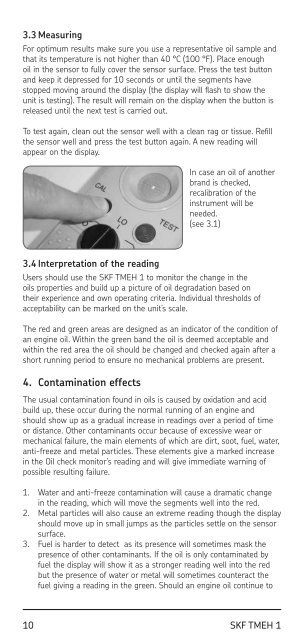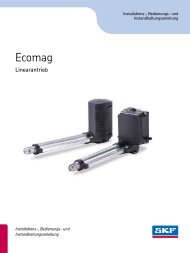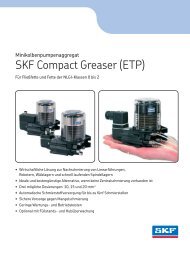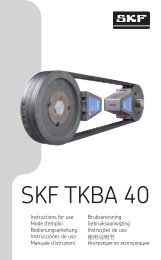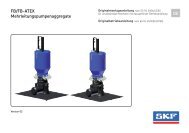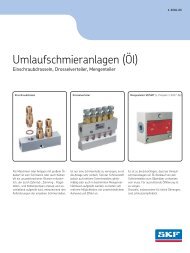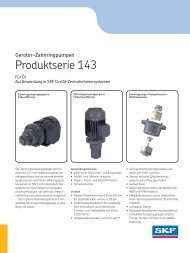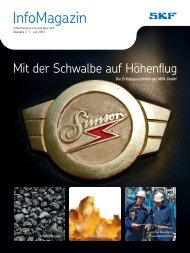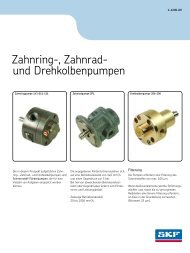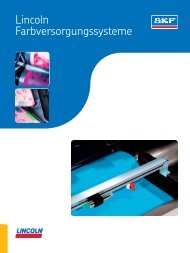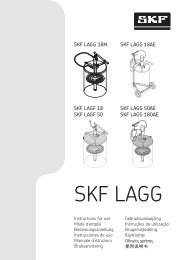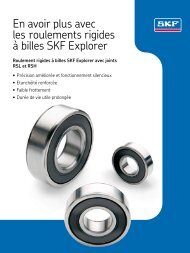Mode d'emploi de TMEH 1 - SKF.com
Mode d'emploi de TMEH 1 - SKF.com
Mode d'emploi de TMEH 1 - SKF.com
Create successful ePaper yourself
Turn your PDF publications into a flip-book with our unique Google optimized e-Paper software.
3.3 Measuring<br />
For optimum results make sure you use a representative oil sample and<br />
that its temperature is not higher than 40 °C (100 °F). Place enough<br />
oil in the sensor to fully cover the sensor surface. Press the test button<br />
and keep it <strong>de</strong>pressed for 10 seconds or until the segments have<br />
stopped moving around the display (the display will flash to show the<br />
unit is testing). The result will remain on the display when the button is<br />
released until the next test is carried out.<br />
To test again, clean out the sensor well with a clean rag or tissue. Refill<br />
the sensor well and press the test button again. A new reading will<br />
appear on the display.<br />
In case an oil of another<br />
brand is checked,<br />
recalibration of the<br />
instrument will be<br />
nee<strong>de</strong>d.<br />
(see 3.1)<br />
3.4 Interpretation of the reading<br />
Users should use the <strong>SKF</strong> <strong>TMEH</strong> 1 to monitor the change in the<br />
oils properties and build up a picture of oil <strong>de</strong>gradation based on<br />
their experience and own operating criteria. Individual thresholds of<br />
acceptability can be marked on the unit’s scale.<br />
The red and green areas are <strong>de</strong>signed as an indicator of the condition of<br />
an engine oil. Within the green band the oil is <strong>de</strong>emed acceptable and<br />
within the red area the oil should be changed and checked again after a<br />
short running period to ensure no mechanical problems are present.<br />
4. Contamination effects<br />
The usual contamination found in oils is caused by oxidation and acid<br />
build up, these occur during the normal running of an engine and<br />
should show up as a gradual increase in readings over a period of time<br />
or distance. Other contaminants occur because of excessive wear or<br />
mechanical failure, the main elements of which are dirt, soot, fuel, water,<br />
anti-freeze and metal particles. These elements give a marked increase<br />
in the Oil check monitor’s reading and will give immediate warning of<br />
possible resulting failure.<br />
1. Water and anti-freeze contamination will cause a dramatic change<br />
in the reading, which will move the segments well into the red.<br />
2. Metal particles will also cause an extreme reading though the display<br />
should move up in small jumps as the particles settle on the sensor<br />
surface.<br />
3. Fuel is har<strong>de</strong>r to <strong>de</strong>tect as its presence will sometimes mask the<br />
presence of other contaminants. If the oil is only contaminated by<br />
fuel the display will show it as a stronger reading well into the red<br />
but the presence of water or metal will sometimes counteract the<br />
fuel giving a reading in the green. Should an engine oil continue to<br />
10 <strong>SKF</strong> <strong>TMEH</strong> 1


